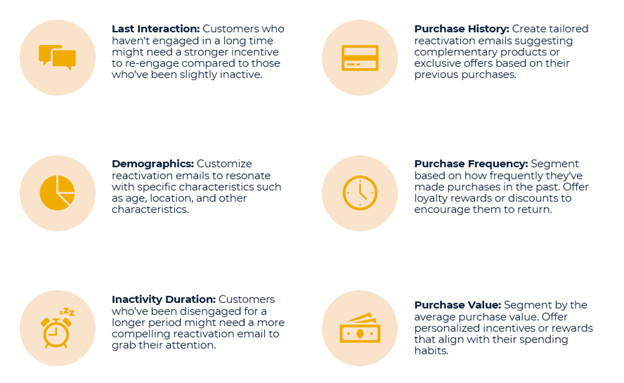Did you know that the probability of selling to an existing customer is 60-70%, while the probability of selling to a new customer is only 5-20%? Developing an email re-engagement strategy can help rekindle lost relationships, recover revenue, and breathe new life into your customer base.
Kym Vance, Head of Business Development, and Larisa Bedgood, Head of Marketing, explore the importance of re-engaging your audience and revitalizing your email database. Get up-to-date on best practices for crafting compelling re-engagement campaigns that not only capture attention but also drive meaningful conversions.
Key Topics
- Why email re-engagement matters
- How to clean up your database to maintain a fresh audience
- Email segmentation tactics to rekindle interest
- Content and design tips to re-capture attention
- Timing and frequency of re-engagement campaigns
- Examples of successful re-engagement campaigns
- & more!
Email Re-Engagement Strategies for Success
This transcript has been adapted from the webinar, Email Re-Engagement: Best Practices for Success.
Larisa: With marketers trying to do more with less budget, email re-engagement is a theme we’ve been hearing quite a bit on recently. So we’ve put together this presentation to get you thinking through re-engagement tactics and offer some of the recommendations we have for success.
I’m sure this is something that’s not new to a lot of you on the webinar today, but you hear that the probability of selling to an existing company, a customer, is 60-70%, while the probability of selling to a new prospect is pretty low, only 5-20%.
Re-engagement is something that should be top of mind. In getting ready for this webinar, Kym and I had a great conversation and she brought up some really good points and things we are hearing from our customers. Do you want to talk through some of these things, Kym?
Kym:
Absolutely! So, we all have a cadence or strategy to talk with our customers and it’s usually pretty consistent. It might be frequent, or might be less frequent. I am connected to certain brands that email me a few times a day. Some will be once a week.
But, as you look at your CRM strategy, there are customers who go dormant or who just don’t engage with your messaging any longer or they don’t buy. Over time, just through general rules of email deliverability, this reduced engagement is going to start dropping your emails to junk folders or to the promotion folders. So the credibility and the reputation of your domains can start to decrease.
So, it’s really important to have different strategies for dormant customers, or those who may have purchased within a certain period of time, or folks who just haven’t purchased in whatever that active window is for your company.
Engagement really is not just through email either. Back in the day, you always heard email and re-engagement in the same sentence. But today, there are more digital channels, more digital touchpoints, and more people doing everything online. It’s important to tie in email with the entire digital ecosystem.
How to Tell When Your Customers Go Inactive: General Guidelines
Larisa: So this is just meant to be some general guidelines and obviously, this is going to be dependent on your brand, your product lineup, and your services, but there are definite cues that your customers are becoming inactive.
Kym, what insights do you have?

Kym: Again, these tend to be general guidelines for brands where you anticipate a purchase from a customer every month, every other month, even once a quarter. So, you know, looking for anything over 90 days of inactivity, and by inactivity, we mean they didn’t open an email.
Or they haven’t engaged with a direct mail campaign. Or any digital efforts. So just really no engagement whatsoever over 90 days.
As that increases over time, it becomes more and more critical to reach them and to gauge their interest.
Obviously, if you have long shelf life solutions, like perhaps, furniture or a car, it might be longer. So it’s finding other ways to keep them engaged in that time between purchases. Maybe it’s accessories or services or tips and tricks of some sort. So educational type messaging.
It’s based on your own product lineup and knowing what your purchase funnel looks like. It’s important just to test to know what your product cycle is and to keep that in mind when you’re sending out your reactivation campaigns.
Prioritize Data Hygiene to Clean Up Your Database
Larisa: The Porch Group Media team has a long history of providing data hygiene solutions. And what we highly recommend is that before you start sending out emails or messages through other channels, you have to make sure you have clean data.
Kym: So, in a lot of cases when consumers do not engage with emails, some companies will tend to stop mailing to them, or they don’t know if the email is still valid and will reach the consumer.
We always recommend a fully vetted hygiene solution on a regular basis. Not just if you’re trying to re-engage clients, but generally, you should be checking the quality of your database at least quarterly, if not more frequently. When you’re looking to do re-engagement, though, one of the key pieces is that people change their e-mail address.
People like myself and many others have multiple email addresses. Studies have shown that the average consumer can have 3 or 4 different emails.
You may have an email address where you’re dealing with all of your important stuff such as family communications, school, insurance, or your bills.
Then you have an email address for work and you might have an email address that you use when you shop – brand communications, newsletters you sign up for, that you might want to check periodically but you don’t want clogging up your inbox every day.
So if you’re looking to re-engage a dormant customer, it’s a good practice to make sure you have as many email addresses for them as possible, so that you can see where they want to engage with you.
So if you have three email addresses for them, it’s okay to send to the three different addresses. They’re not likely going to respond from all of them. They might unsubscribe from some of them, but it does put you in the direction of where they want to hear from you so it can be valid.
Should you email all those addresses all the time? Absolutely not. You you have to pay attention to where they are reacting positively and then net down on those addresses, especially with doing a large engagement campaign.
We recently ran a reactivation campaign for one of our sister companies. A lot of these records were in the purchase cycle of maybe a year plus. So we had to make sure that we cleaned and verified those emails, because if we had sent those out to bad email addresses, there goes our IP reputation or sending reputation.
It’s just a really important step to make sure that you’re sending out emails that have been validated and they’re clean just to protect your own reputation.
Segmentation Tactics for Re-engagement
Larisa: This to me is always really interesting. When I’m going through my emails, if there’s something that I haven’t engaged with in a while, I always notice what type of offers they are giving, being I do marketing for a living!
We hear about personalization being so important to capture the attention of consumers and customers. And this is no different with re-engagement. You’ve got to segment. It can’t just be one blast to your entire unengaged audience but needs to be based on commonalities. Maybe decide to segment by the last interaction and/or purchase history.
Kym: This is where the right message, right time is so important. There are a wealth of factors that should drive how you segment your re-engagement initiatives.

You really have to look at each group and communicate with a series of messages that show you really value them as a customer. The messaging needs to be relevant – maybe based on items they have purchased in the past or maybe their purchase frequency, so again, this is going to be very custom.
This is a bit of a plug, but this is where our team is really strong in helping brands gain an understanding of their customer base such as where they tend to drop off, and by identifying other trends and putting a strategy together that will really be compelling to the reactivation story.
So that could be message frequency, message content, number of messages in a series when you bring them into other channels.
Pay Special Attention to Your Subject Line
Larisa: Segmentation is about personalization and the same attention should be paid to your subject line. You can see from this stat here that, almost 1 in 2 people will decide whether or not to open an e-mail based on the subject line alone.
Here’s where we advocate to just test, test, test. You just don’t know what’s going to work until you try it.
Examples:
- Use Personalization: Include the recipient’s name or reference their past interactions.
Example: “Hey Larisa, We Miss You!” - Create Curiosity and Intrigue: Pose questions or tease valuable content.
Example: “Guess What’s Inside? [Hint: Exclusive Offer]” - Highlight an Exclusive Offer or Benefit: Mention discounts, freebies, or unique benefits.
Example: “Unlock 20% Off Your Next Purchase! 🎁” - Inject Urgency and FOMO (Fear of Missing Out): Use time-sensitive language to create a sense of urgency and the fear of missing out on something valuable.
Example: “Last Chance to Redeem Your Special Gift! ⏳” - Ask a Provocative Question: Pose a question that encourages subscribers to reflect on their relationship with your brand or rekindle their interest.
Example: “Is it Time to Fall in Love with [Your Brand] Again?”
Kym: The ones that tend to be most successful are when you put value in front of the customer.
But as in all things marketing, you’ve just got to test. Maybe you think that a percent off is going to be great. But in reality, on your next go around, you test out something different and you get maybe a two times response, so don’t be afraid to not be successful on your first attempt and don’t be afraid to try something different.
We’re not necessarily going to get it right on the first go-round. We would love to, but that’s part of marketing, it’s testing, testing, testing, and seeing what works.
Did you enjoy this transcript? Watch the full on-demand webinar for more great insights on email re-engagement best practices.






